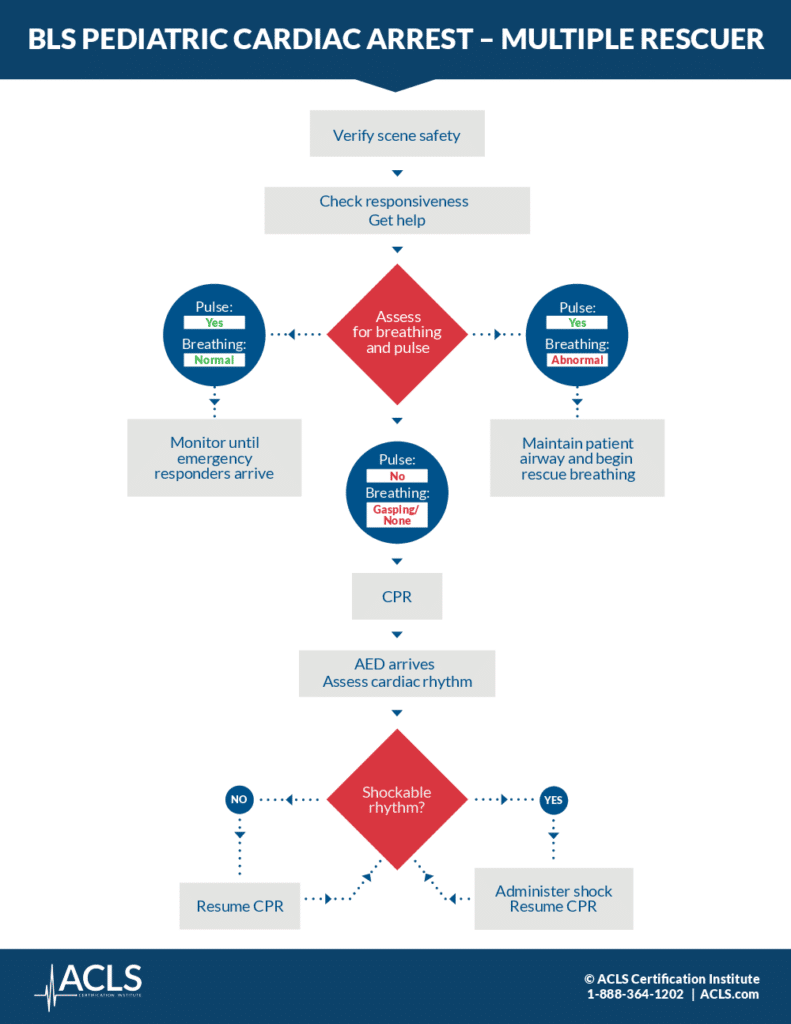BLS Pediatric Cardiac Arrest Algorithm – Multi Rescuer


- Verify scene safety. If you encounter a potential cardiac arrest victim, first make sure the scene is safe for both the rescuers and the victim.
- Check responsiveness. Get help. Check for responsiveness. First tap the victim and shout “HEY! HEY! Are you OK?” If they do not respond, get help. The first rescuer should remain with the victim while the second rescuer activates the emergency response system and retrieves the AED and other emergency equipment.
- Assess for breathing and pulse. Check for absent or abnormal breathing by watching the chest for movements for 5 to 10 seconds. Simultaneously check for a pulse for a minimum of 5 seconds—but no more than 10 seconds. To perform a pulse check in an infant, palpate a brachial pulse. In a child, palpate a carotid or femoral pulse. It’s important to minimize delay in starting CPR, so take no more than 10 seconds to assess the patient.
- If the victim has a pulse and is breathing normally, monitor them until emergency responders arrive.
- If the victim has a pulse but is breathing abnormally, maintain the patient’s airway and begin rescue breathing. Administer one breath every 3 to 5 seconds, or 12 to 20 breaths per minute. Check the patient’s pulse every 2 minutes. Add compressions if the pulse is less than or equal to 60 beats per minutes with signs of poor perfusion. If at any point there is no pulse present, begin administering CPR.
- Begin CPR. If a pulse is not identified within 10 seconds, the first rescuer should immediately begin administering CPR, starting with chest compressions. Compressions should occur at a rate of 100 to 120 compressions per minute, at one third the depth of the chest. For an infant, use the 2-finger chest compression technique while only one rescuer is present. Once the second rescuer returns, us the 2 thumb-encircling hands technique. For a child, use one or two hands, whatever is needed to provide adequate compression depth. Use a compression-to-ventilation ratio of 30 compressions to 2 breaths until the second rescuer returns. When the second rescuer returns use a compression-to-ventilation ratio of 15 compressions to 2 breaths.
- Attempt defibrillation with the AED. Use the AED as soon as it is ready. Follow the prompts on the AED to check for a shockable rhythm.
- If the AED advises that the patient has a shockable rhythm, follow the prompts, clear the patient, and deliver the shock. Immediately resume CPR, starting with compressions, for 2 minutes or until the AED prompts you to check the patient’s rhythm again. Compressions should not be discontinued for more than 10 seconds. Continue providing CPR and following the AED prompts until ALS providers can take over or the victim begins to breathe, move, or react.
- If the AED advises that the patient’s rhythm is nonshockable or no shock is advised, immediately resume CPR, starting with compressions. Continue CPR for 2 minutes, or until the AED prompts you to check the patient’s rhythm again. Compressions should not be discontinued for more than 10 seconds. Continue providing CPR and following the AED prompts until ALS providers can take over or the victim begins to breathe, move, or react.
Benefits of Multiple BLS Certified Rescuers During Pediatric Cardiac Arrest
If a child goes into cardiac arrest, rescuers certified in Basic Life Support (BLS) can save the child’s life if they act quickly. In such a scenario, having multiple BLS-certified rescuers on the scene who can follow the pediatric BLS algorithm for cardiac arrest would be even more helpful. The BLS pediatric cardiac arrest algorithm provides instructions for two certified rescuers. When these two rescuers follow the algorithm and work as a team, they maximize the chances of keeping the child alive until help arrives.
With two BLS-certified responders on the scene, they can also work together to save time. One rescuer can remain with the victim and begin life support measures as needed. The other can call emergency services for help and retrieve any equipment that might be required, like a defibrillator. By separating tasks, the first rescuer can begin life support sooner. In addition, the second rescuer will deliver any equipment they might need, so the first rescuer won’t have to stop giving life support to gather gear.
The benefits of multiple BLS-certified rescuers are clear, but it is also imperative that the rescuers communicate. They must immediately and clearly identify who is the first rescuer and who is the second rescuer. If both rescuers believe they are second, they may both head for the equipment and leave the victim unattended and without life support.
